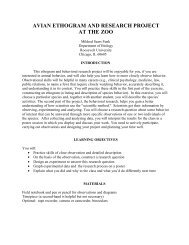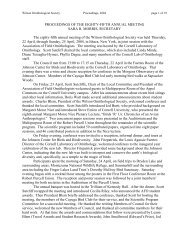Available now - Wilson Ornithological Society
Available now - Wilson Ornithological Society
Available now - Wilson Ornithological Society
You also want an ePaper? Increase the reach of your titles
YUMPU automatically turns print PDFs into web optimized ePapers that Google loves.
WOS 2010 ~ ABSTRACTS p. 18<br />
important habitat for grassland birds. This study explored the effects of rotational grazing (RG) and other habitat<br />
variables on relative abundance of grassland birds on small dairy farms in Wisconsin, Pennsylvania and New York.<br />
Grassland birds were more likely to occur on grazing farms than confinement farms, and Bobolinks (Dolichonyx<br />
oryzivorus) showed significantly higher abundances on RG farms. Grassland bird abundance was positively<br />
associated with grassland area at multiple scales. Preliminary analysis suggests that grassland bird abundance is<br />
influenced by interacting factors including land cover, patch area, and landscape fragmentation. Results from this<br />
analysis will help determine best practices for conserving grassland birds on dairy farms.<br />
15 Fifteen years of research on grassland birds in New York State: habitat relations and management implications.<br />
Christopher Norment, Dept. Environmental Science and Biology, College at Brockport, State Univ. New York,<br />
Brockport, NY 14420<br />
Grassland birds are declining throughout North America due to the loss and deterioration of grassland habitat. In the<br />
Northeast, culturally altered landscapes, such as agricultural grasslands, receive the periodic disturbance needed to<br />
maintain habitat for obligate grassland breeding birds. A large body of data from fifteen years of research in western<br />
and northern New York demonstrates that large anthropogenic grasslands dominated by cool season, primarily<br />
nonnative, grasses support high numbers of obligate grassland breeding birds, particularly when the vegetation is<br />
relatively short and less dense. In addition, grassland bird breeding bird productivity in nonnative cool season<br />
grasslands at several non-fragmented study sites in the region is higher than in many parts of the Midwest. In<br />
contrast, many anthropogenic warm season grasslands in the region support few obligate grassland breeding birds,<br />
and may have relatively low productivity. These patterns, along with work by other researchers, suggest that the<br />
large expanses of anthropogenic grasslands in New York State are an important regional and continental resource<br />
for grassland bird conservation, and that management efforts should incorporate privately owned lands in<br />
agricultural landscapes, maintain large areas of grassland habitat, and promote the use of low-stature cool season<br />
grasses.<br />
16 S The effects of exurbanization on the food and habitat of Pileated Woodpeckers (Dryocopus pileatus). Marie E.<br />
<strong>Wilson</strong>, Jordan M. Casey, and David G. Haskell, Dept. Biology, Univ. of the South, Sewanee, TN 37383, and<br />
Nicholas Hollingshead, Landscape Analysis Lab, Univ. of the South, Sewanee, TN 37383<br />
Pileated Woodpeckers (Dryocopus pileatus) require large and/or dead trees for nesting, roosting, and feeding. In<br />
exurban areas, or places of low-density rural development, the status of such a mature forest habitat is poorly<br />
k<strong>now</strong>n. Using proportion impervious cover as a proxy for exurbanization, we hypothesized that as exurbanization<br />
increased, average tree diameter and number of large trees, volume and rot class of standing/fallen dead trees, ant<br />
and grub abundance in the soil and leaf litter, and Pileated Woodpecker presence would decrease. Volume and rot<br />
class of dead wood, ant and grub abundance, and presence of Pileated Woodpeckers did not change as<br />
exurbanization increased. Average tree diameter (P < 0.001) and number of trees above 60 cm in diameter (P =<br />
0.015) however, increased with increasing exurbanization. Number of trees in general did decrease with increasing<br />
exurbanization (P < 0.001) but Pileated Woodpecker presence showed no relation to number of trees and did show a<br />
relation to tree diameter as points with Pileated Woodpeckers had larger average tree size than points without (P =<br />
0.014). Due to such a lack of difference in select habitat characteristics between exurban and forested areas and a<br />
difference in favor of exurban areas in regards to larger trees, our data suggests that some exurban areas may<br />
provide suitable habitat for Pileated Woodpeckers. In addition, forest assessments have commonly noted any<br />
forested areas with residential uses as non-forest, but our data suggests that some exurban areas show structural<br />
similarities to forests and should thus be a sub-group of forested areas.<br />
17 S Ovenbird spatial behavior at an urban stopover site: Movement patterns, stopover durations, and the influence of<br />
arrival condition. Chad L. Seewagen, Dept. Biology, Univ. Western Ontario, London, ON N6G 5B2 and Dept.<br />
Ornithology, Wildlife Conservation <strong>Society</strong>, Bronx, NY 10460, and Christopher G. Guglielmo, Dept. Biology,<br />
Univ. Western Ontario, London, ON N6G 5B2<br />
Migration routes of many Nearctic-Neotropical landbirds pass through the most urbanized regions of North<br />
America. Migrants are k<strong>now</strong>n to use urban habitats as stopover sites and often occur in cities at exceptional density;<br />
yet k<strong>now</strong>ledge of migrant behavior and ecology in such places is surprisingly limited. We radio-tracked ovenbirds<br />
(Seiurus aurocapillus) during stopovers in a New York City park to obtain some of the first detailed information on<br />
how landbird migrants utilize an urban habitat as a stopover site. We examined fine-scale movement patterns, home<br />
range sizes, stopover durations, and how arrival condition affected each of these metrics. During both seasons, most<br />
birds moved widely throughout the site upon presumed arrival and then either continued migration that night or<br />
settled into a more defined area on subsequent days. Area usage varied markedly between individuals during both<br />
seasons, ranging 1-16 ha. Stopover durations averaged 3.0 days (range= 1-10 days) during spring and 2.9 days<br />
(range= 1-14 days) during autumn. Spatial behaviors and stopover durations were not influenced by arrival<br />
condition during spring, and during autumn, only movement rates and displacement distances were significantly





